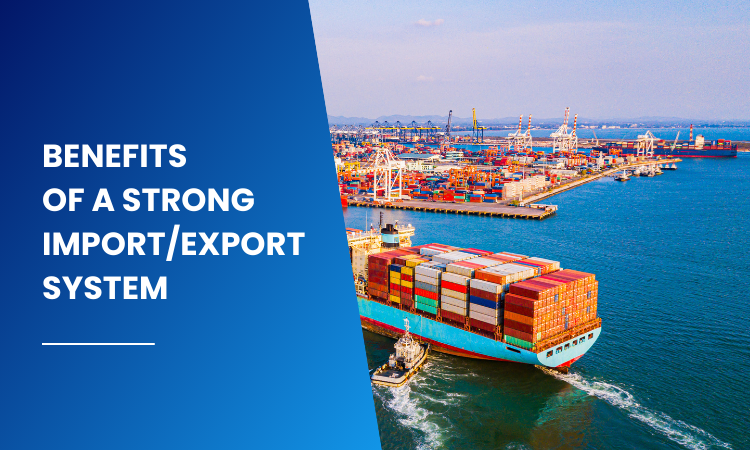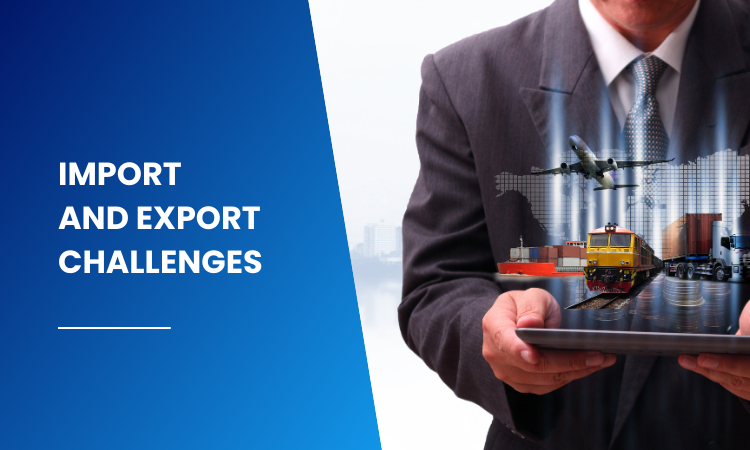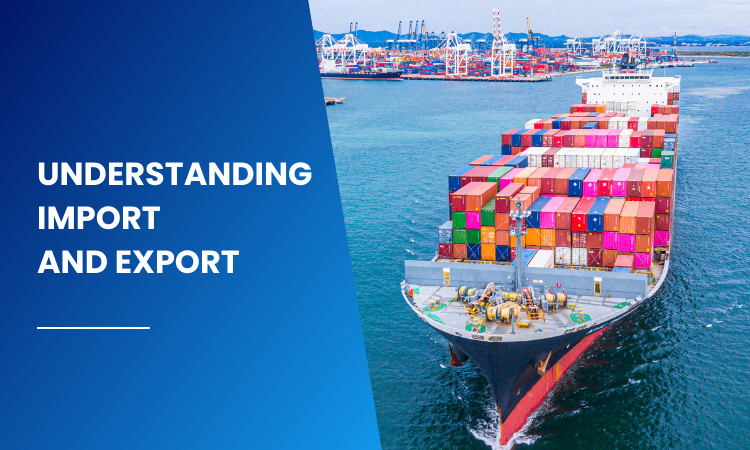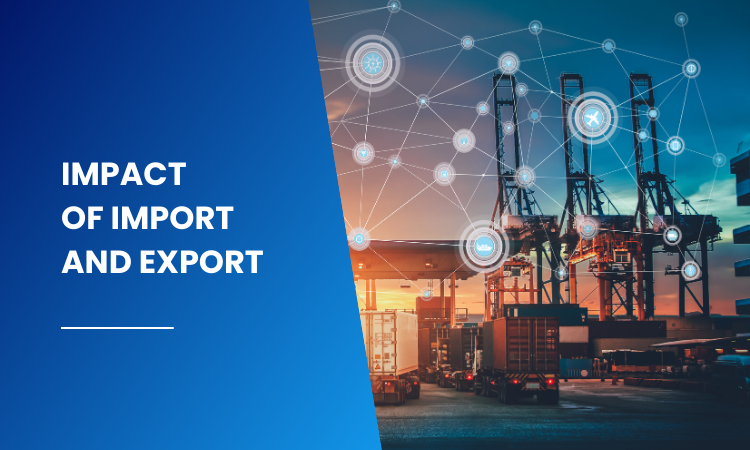Introduction
Global trade is a big part of any country’s economy these days because everything is linked. Importing and exporting are the most important parts of this trade, so it’s important to understand what they mean. This blog will talk about the many ways a strong import and export system is good for a country. It will look at how it can help the economy grow, create jobs, and raise the living standards of its people.

Unlocking Prosperity: The Benefits of a Strong Import/Export System
Consider a nation cut off from the outside world and confined to its own borders, with no means of trading products or services. Variety and innovation would probably stagnate, even though it might create some things. The reality made possible by a robust import/export system, which serves as a doorway to worldwide prosperity, is the complete reverse of this.
A nation can reap a multitude of advantages with a strong import/export system. Primarily, it provides access to a greater variety of products and services at reasonable costs. Businesses are able to acquire components or raw materials more effectively, while consumers have access to products that they might not find domestically. In the end, this helps everyone by creating a more vibrant and competitive market.
Secondly, a robust import/export framework generates a potent catalyst for economic expansion. Businesses that export their own products and services can reach a far wider market, which boosts output, creates jobs, and eventually raises national wealth. Because of this expansion, the government has a larger revenue base to support investments in social programs, infrastructure, and education.
Additionally, import/export promotes a good amount of rivalry. Exposure to new foreign items forces domestic producers to enhance their own offers. Both home consumers and foreign markets gain from this ongoing drive for innovation, which raises the standard of products and services worldwide.
But a well-functioning system is needed to unlock these advantages. It’s critical to understand the complexities of import/export paperwork. Comprehending procedures, tariffs, and quotas guarantees seamless customs clearance and prevents expensive delays. In this process, forming alliances with seasoned logistics firms can be quite beneficial.
The Future of Trade: How Technology is Shaping Import and Export
A lot of big changes are happening in foreign trade because technology keeps getting better and better. Technology is changing how countries buy and sell things and services by streamlining processes and coming up with new ideas.
Efficiency is one of the most important effects. Documentation for importing and exporting is changing a lot thanks to technologies like blockchain. This safe, decentralized method makes document processing faster and more clear, cutting down on wait times and administrative work. E-commerce sites have also made it easier for businesses to reach customers in other countries, which has lowered the barriers to entry and grown markets.
AI, or artificial intelligence, is also becoming more important. Logistics systems that use AI can make supply lines more efficient by suggesting the best routes and ways to transport goods. Because of this, delivery times are shorter and prices are lower for both customers and companies. Also, AI can look at huge amounts of trade data and give businesses useful information about market trends and customer tastes, which helps them decide how to import and export.
There are some problems that come up with technology. As trade moves more and more online, cybersecurity risks are becoming a bigger problem. In the import/export sector, tasks that are automated could also cause people to lose their jobs in some places. These problems can be lessened, though, with training programs and other upskilling efforts.

Success Stories: How Countries Thrive Through Import and Export
Importing and exporting are more important than just ideas. There are many countries in the world that show how powerful a strong foreign trade system can be. Let’s look at a few examples:
South Korea:
With a deliberate emphasis on exports, South Korea, formerly a war-torn country, has become a global economic powerhouse. They picked out important industries, like electronics and cars, put a lot of money into research and development, and went after foreign markets aggressively. This growth that was driven by exports produced jobs, pushed infrastructure development and raised living standards by a large amount.
Vietnam:
Vietnam’s economy has changed dramatically over the past few decades, moving from a centrally controlled to a thriving export-oriented economy. Vietnam has become a major player in the world’s manufacturing sector by drawing foreign investment with good trade policies and a skilled workforce. Millions of people have been lifted out of poverty by this growth that was powered by imports. The country is on its way to becoming a big economic force in Southeast Asia.
Singapore:
Even though Singapore is a small island country with few resources, it has become a global trade hub by taking advantage of its good location and strong facilities for importing and exporting. Singapore has made itself an important part of the global supply chain by putting money into improving its ports, logistics networks, and customs processes. Singapore has become a model for development by focusing on making foreign trade easier. This has helped the economy grow and stay strong.
When you buy and export, things can change. These success stories show that. Countries can boost their economies, create jobs, and make people’s lives better by using these methods in smart ways. Different countries can make their own way to a prosperous future by studying these models and creating an environment that is good for trade.

Common Import and Export Challenges and How to Overcome Them
Although the world of imports and exports is full of opportunities, it also has its own set of problems. This article talks about some of the most common problems businesses have and how to solve them:
Controls on importing and exporting goods can be complicated and differ between countries. Missing or wrong paperwork can cause delays, fines, or even the seizure of a package. Deal with a trustworthy customs broker or freight forwarder. Their knowledge makes sure that all the paperwork is correct and follows the rules, which speeds up the process.
Dealing with the physical movement of things across borders can be hard. Selecting the cheapest and most effective transportation path, getting through customs, and dealing with possible delays all require careful planning. For real-time tracking, route optimization, and communication with carriers, use logistics systems that are powered by technology. As a result, possible problems can be managed before they happen.
The constantly changing foreign exchange market can have an effect on making money. Unexpected changes in the value of a currency can cut into profits or make exports less competitive. To lower your danger, think about currency hedging strategies. Businesses can make a plan to handle their foreign exchange risk by talking to financial experts.
It is very important to understand cultural differences when doing business with people from other countries. Being sensitive to other cultures can help you build better relationships with people from other countries. This includes things like how you talk to them and how you negotiate. Pay for training in cultural competence for workers who do import and export work. Finding out about the habits and standards of your target market can help you build trust and make partnerships that work.

Understanding Import and Export: A Country's Economic Lifeline
In today’s globally linked world, a country’s economic health is closely linked to its capacity to trade with other countries. In this economic system, imports and exports are like the veins that carry things and services across borders. But how exactly do these processes keep a country’s economy going?
Imagine a country that relied only on its own output. It could make some things, but it probably wouldn’t be very creative or varied. This gap is filled by imports. Imports make the market more active by giving people access to more things and resources. Consumers get a wider range of goods, and businesses can get raw materials or parts that aren’t available in their own country.
But on the other hand, exports are what make the economy grow. When businesses successfully enter foreign markets, they can get a lot more customers. This can lead to more production, more jobs, and a higher national income overall. The government can make investments in infrastructure, education, and social services that help everyone because of this growth, which means a bigger tax base.
Besides that, importing and exporting create a good amount of competition. When Americans see new, innovative products from other countries, it makes American companies improve their own goods to stay competitive in the global market. Innovation is always being pushed, which improves the quality of all goods and services. This is good for both domestic and foreign markets.
But this economic support needs to be carefully managed in order to work. It is very important to understand and follow the import/export paperwork to make sure that customs clearance goes smoothly and that you don’t have to pay extra for delays. Working with logistics companies that have a lot of knowledge can be very helpful in this process.

Navigating the Trade Winds: A Guide to Import/Export Procedures
The world of imports and exports is full of opportunities, but it can be scary for people who have never been there before. Do not be afraid, brave trader! This guide will give you the information you need to get through the necessary steps and make sure your import/export trip goes smoothly.
Understanding the Basics
The first thing you need to do is learn about the specific rules that apply to your importing or exporting. Find out about the important government agencies and any license requirements, limits, or tariffs that might be in place. It is also very important to understand the Harmonized method (HS) coding method. This worldwide standard sorts traded goods into groups that make it easier to identify them and get them through customs.
Documentation Do’s and Don’ts
For a smooth import/export process, documentation that is correct and full is very important. Commercial contracts, packing lists, certificates of origin, and bills of lading are all common types of papers. Working with a customs broker can be very helpful because they know how to make sure that all of your paperwork follows all the rules. Remember that even small mistakes can cause delays or fines, so it’s important to be very well prepared.
Modes of Transportation
Several things, like the type of goods, how quickly they need to get there, and your budget, affect which means of transportation is the most efficient and least expensive. Ocean freight, air freight, or land shipping are all options. A freight forwarder can help you look at your choices and pick the one that meets your needs best.
Additional Considerations
Besides the basic steps, don’t forget to think about insurance for your goods to lower any risks that might happen during (shipping). Also, knowing about changes in global trade and possible problems, like political unrest or natural disasters, can help you plan ahead and make changes as needed.
The Global Marketplace: How Import and Export Drive Growth
Picture a world where countries can’t trade things and services with each other. There would be less innovation, and customers would have fewer choices. Fortunately, things are far more dynamic in reality. The global market is powered by imports and exports, which help the economy grow and spread wealth around the world.
When a country imports, it gets access to more goods and materials than it could make itself. Seeing these foreign goods makes people want to compete. When domestic companies see new products from other countries, it pushes them to make their own products and methods better. This never-ending drive for progress makes all goods and services better, which is good for both domestic and foreign markets.
Export helps businesses get started and takes them to the world stage. By selling their goods and services in other countries, businesses can get a lot more customers. This can lead to more output, more jobs, and a higher national income overall. The government can now afford to spend more in infrastructure, education, and social programs that help everyone because of this growth.
Buying and selling goods abroad makes everyone richer. The world economy grows when countries trade with each other. Because of this, countries feel more dependent on each other and work together to keep the trading situation stable and predictable. This is good for everyone in the long run, making the world wealthier and more linked.
But getting around in the global market needs a method that works well. For quick customs clearance and no delays, it’s important to know and follow the rules for importing and exporting, including having the right paperwork. Partnering with experienced transportation companies can be very helpful for making sure that the process of importing and exporting goes smoothly.
From Local to Global: How Businesses Can Leverage Import and Export
Do you want to grow your company from a regional success story to an international force? You only need to look at the fascinating realm of import and export. Businesses of all sizes may seize a wealth of chances and establish themselves globally by effectively utilizing these potent tools.
You can increase the range of products you offer by importing more than what is available locally. This might give you a competitive edge in the market by meeting a larger range of client wants and preferences.
Your potential sales and revenue might increase significantly by exporting because it gives you access to a large worldwide consumer base. Envision your artisanal furnishings being cherished in residences worldwide! But going international needs careful preparation. Success depends on thoroughly analyzing target markets, comprehending cultural quirks, and adhering to global laws.
You can obtain components or raw materials at competitive prices through importation, which may result in cost savings and increased profit margins. This can be especially helpful for companies operating in sectors with little domestic resource availability. By avoiding reliance on the home market, exporting can also help you diversify your client base and reduce risk.
If you can handle import and export well, your brand can go from being a local darling to a major participant in the international market. Your reputation might be improved and new clients can be drawn in from all over the world by this exposure.
Though it could appear overwhelming, the import and export industry is not to be ignored. You can find a lot of resources to guide you through the procedure. Working with a trustworthy freight forwarder or customs broker can give you access to priceless knowledge of rules and paperwork. Governmental organizations also frequently provide assistance programs for companies starting foreign trading.

The Impact of Import and Export on Jobs and Living Standards
Beyond intricate logistics and financial data, import and export operations involve other factors as well. Every day people’s lives are significantly impacted by it. A country can raise the standard of life for its residents and increase job possibilities for others by cultivating a robust import and export system.
Business:
Businesses with an emphasis on exports are major producers of jobs. These businesses frequently experience production increases as their customer base grows internationally, necessitating the hiring of additional personnel in a variety of fields, including logistics and manufacturing. Jobs in distribution, warehousing, and customs brokerage are also produced by a thriving import industry.
Goods & Services:
A wider variety of goods and services at affordable rates are available to consumers because of importation. In the end, this wider range of options leads to better products at more reasonable costs by encouraging innovation and competition in the home market. Citizens can benefit from a higher standard of living as a result of having more buying power.
Knowledge & Talents:
Knowledge and talents are shared and influenced by each other through commerce. Domestic industry breakthroughs might result from exposure to overseas enterprises and production practices. In addition, the need for workers with knowledge in logistics and foreign languages—skills related to import and export operations—can stimulate educational and training initiatives, producing a workforce with higher levels of skill.
National Income:
Stronger national income for the government is a direct result of a robust import and export industry. This makes more funding possible for important infrastructure initiatives like communication and transportation networks. By making it easier for people and commodities to move around, these advancements not only help companies that engage in (international trade) but also make life better for all residents.
The advantages of import and export aren’t split equally, though, and this needs to be acknowledged. Policies that reduce the possibility of job losses in specific industries as a result of higher imports must be put in place by governments in order to guarantee that the benefits of global trade are distributed fairly among the populace.
Beyond Borders: The Importance of Import and Export Trade
National borders are getting more porous when it comes to trade in today’s globalized globe. These days, import and export are essential to a healthy global economy rather than being niche endeavors. However, why is trade in goods and services so important to nations? Now let’s explore further.
Resources & Items:
A greater variety of resources and items are available to nations through importation than they could be produced locally. Customers gain from increased variety and possibly reduced pricing as a result of this creating a more dynamic economy. Consider a coffee business that only sells domestic beans; with import access, they may provide unique mixes and serve a larger clientele.
Businesses:
Businesses use exporting as a springboard to take them onto the international scene. Companies can greatly enhance the size of their client base by entering foreign markets. This can result in higher production, the creation of jobs, and eventually a rise in the national revenue. As a result, the government will have a larger revenue base to work with, allowing it to make expenditures in infrastructure and education.
Export and import:
Export and import generate a good amount of rivalry. When challenged with cutting-edge foreign items, domestic companies are motivated to enhance their product lines and operational procedures. All things considered, the quality of goods and services is higher as a result of this ongoing drive for progress. Consider a local apparel manufacturer. Import rivalry may encourage them to employ novel materials or styles, which would benefit both local and foreign customers.
Prosperity:
Prosperity is spread through import and export. The global economy grows when nations trade with each other. Because of their interconnectedness, nations are more likely to feel interdependent and cooperate in order to preserve a stable and predictable trading environment. In the end, this is advantageous to all parties and creates a more wealthy and connected globe.
Notwithstanding the indisputable advantages, managing the import and export industry needs meticulous preparation and strict compliance with laws. Comprehending import/export paperwork and collaborating with seasoned logistics firms can guarantee a seamless encounter.
Conclusion
An economy that is growing is built on a strong import and export system. Nations can increase their access to a greater variety of goods and services, generate employment, and improve the standard of living for their population by promoting commerce internationally. Businesses as well as people can actively participate in this economic engine by being aware of the complexities involved in import and export procedures, particularly the significance of appropriate documentation.
